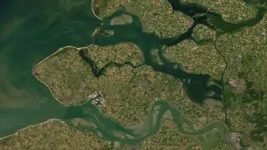(Press-News.org) Turbid waters keep the coast healthy
To preserve the important intertidal areas and salt marshes off our coasts for the future, we need more turbid water. That is one of the striking conclusions from a new study conducted by a Dutch-Chinese team of researchers and published today in Nature Geoscience."These natural areas outside our dikes are essential for nature and coastal defense. But because how we are now building in the Delta and the hinterland, coastal defense is endangered in the long term," warns NIOZ researcher Tim Grandjean.
Satellite measurements
For his research, Grandjean linked decades of satellite measurements of tidal areas around the world with data on the turbidity of the water, which is also measured by satellites. Importantly, Grandjean has established a lower limit for the necessary turbidity of the water in deltas worldwide. A very clear relationship emerged in the long term: intertidal areas only grow when the water is turbid enough. "After all, turbid water means more sand and silt particles in the water, which can allow the coast to grow," the researcher explains.
Vulnerable tidal flats due to human interventions
Worldwide, the turbidity of many coastal waters has been declining for decades, making the tidal flats sensitive to loss. Additionally, sea level rise requires that water has higher turbidity to continue to maintain tidal flats. The relatively low turbidity globally threatens essential areas for biodiversity and coastal safety. After all, tidal flats are important foraging areas for birds and contribute to wave attenuation.
Coastal defenses must improve
Globally, the determination of the necessary turbidity for the preservation of tidal flats by Grandjean provides an essential basis for rethinking human interventions in deltas. We need to think more carefully about the ways in which human activities affect the coast, on which we rely for our safety. These challenges are not unique to any one region but are evident globally due to extensive human modifications to natural water systems. For instance, the construction of large dams, such as the Three Gorges Dam on the Yangtze River, has significantly reduced the sediment supply downstream. This reduction is crucial for the propagation of tidal flats, leading to sediment starvation that hinders the natural rebuilding of intertidal zones, vital for coastal protection and biodiversity.
Similarly, in the Netherlands, the construction of the storm surge barrier in the Oosterschelde in the 1980s has led to severe 'sand starvation'. Because of this barrier, less sand can flow from the North Sea into the estuary, resulting in clearer water that fails to replenish the intertidal areas, thus causing them to erode. "In the long run, this is not sustainable," Grandjean believes. "When too much intertidal area disappears outside the dikes of Zeeland, the safety of the complete coast is at stake. So not only for nature, but also for safety, we must begin to protect the areas outside the dikes much more effectively. The water has to become murkier, so we may have to consider dismantling the Oosterschelde storm surge barrier in the future. A careful balance between nature conservation and coastal protection is essential, ensuring that both goals strengthen rather than counteract each other."
Detailed measurements provide insight
Tim Grandjean defended his PhD on this topic on April 24th and has also collected new data on the dynamics of intertidal areas. These data provide insight into the short-term vulnerability. He used a technique that was developed in NIOZ workshops. "The dynamics of intertidal areas can be measured with very expensive sensors or with labour-intensive, manual measurements. However, this way, we could never collect data in many different places at the same time. The technicians at NIOZ developed sensors that were cheap enough to record the height of the bottom to the millimetre, several times a day, at different locations along the Western and Eastern Scheldt for several years now."
Heavy dynamics
Those precise measurements show that at high tide, an intertidal zone can easily vary one or two centimeters in height within a single day. "For you or me, a centimeter more or less under our boots may not matter, but if you are a worm or a mussel, or a seed of eelgrass, that is indeed too much dynamics," Grandjean says.
Measures that can work
Grandjean also looked at the grounds between groynes constructed by the province of Zeeland, to improve the quality of tidal nature along part of the banks of the Westerschelde. "Of course, we already knew that these groynes, along rivers and coasts, can protect, but our measurements show that benthic life along the Westerschelde also benefits from these measures. The dynamics decrease enough in time and space for benthic animals to settle better." Additionally, the reduction in flow between the groynes could potentially benefit the stability of the intertidal coastal areas in the long term and mitigate the effects of rising sea levels. However, further research is essential for understanding this dynamic and its long-term effects.
To preserve the important intertidal areas and salt marshes off our coasts for the future, we need more turbid water. That is one of the striking conclusions from a new study conducted by a Dutch-Chinese team of researchers and published today in Nature Geoscience."These natural areas outside our dikes are essential for nature and coastal defense. But because how we are now building in the Delta and the hinterland, coastal defense is endangered in the long term," warns NIOZ researcher Tim Grandjean.
Satellite measurements
For his research, Grandjean linked decades of satellite measurements of tidal areas around the world with data on the turbidity of the water, which is also measured by satellites. Importantly, Grandjean has established a lower limit for the necessary turbidity of the water in deltas worldwide. A very clear relationship emerged in the long term: intertidal areas only grow when the water is turbid enough. "After all, turbid water means more sand and silt particles in the water, which can allow the coast to grow," the researcher explains.
Vulnerable tidal flats due to human interventions
Worldwide, the turbidity of many coastal waters has been declining for decades, making the tidal flats sensitive to loss. Additionally, sea level rise requires that water has higher turbidity to continue to maintain tidal flats. The relatively low turbidity globally threatens essential areas for biodiversity and coastal safety. After all, tidal flats are important foraging areas for birds and contribute to wave attenuation.
Coastal defenses must improve
Globally, the determination of the necessary turbidity for the preservation of tidal flats by Grandjean provides an essential basis for rethinking human interventions in deltas. We need to think more carefully about the ways in which human activities affect the coast, on which we rely for our safety. These challenges are not unique to any one region but are evident globally due to extensive human modifications to natural water systems. For instance, the construction of large dams, such as the Three Gorges Dam on the Yangtze River, has significantly reduced the sediment supply downstream. This reduction is crucial for the propagation of tidal flats, leading to sediment starvation that hinders the natural rebuilding of intertidal zones, vital for coastal protection and biodiversity.
Similarly, in the Netherlands, the construction of the storm surge barrier in the Oosterschelde in the 1980s has led to severe 'sand starvation'. Because of this barrier, less sand can flow from the North Sea into the estuary, resulting in clearer water that fails to replenish the intertidal areas, thus causing them to erode. "In the long run, this is not sustainable," Grandjean believes. "When too much intertidal area disappears outside the dikes of Zeeland, the safety of the complete coast is at stake. So not only for nature, but also for safety, we must begin to protect the areas outside the dikes much more effectively. The water has to become murkier, so we may have to consider dismantling the Oosterschelde storm surge barrier in the future. A careful balance between nature conservation and coastal protection is essential, ensuring that both goals strengthen rather than counteract each other."
Detailed measurements provide insight
Tim Grandjean defended his PhD on this topic on April 24th and has also collected new data on the dynamics of intertidal areas. These data provide insight into the short-term vulnerability. He used a technique that was developed in NIOZ workshops. "The dynamics of intertidal areas can be measured with very expensive sensors or with labour-intensive, manual measurements. However, this way, we could never collect data in many different places at the same time. The technicians at NIOZ developed sensors that were cheap enough to record the height of the bottom to the millimetre, several times a day, at different locations along the Western and Eastern Scheldt for several years now."
Heavy dynamics
Those precise measurements show that at high tide, an intertidal zone can easily vary one or two centimeters in height within a single day. "For you or me, a centimeter more or less under our boots may not matter, but if you are a worm or a mussel, or a seed of eelgrass, that is indeed too much dynamics," Grandjean says.
Measures that can work
Grandjean also looked at the grounds between groynes constructed by the province of Zeeland, to improve the quality of tidal nature along part of the banks of the Westerschelde. "Of course, we already knew that these groynes, along rivers and coasts, can protect, but our measurements show that benthic life along the Westerschelde also benefits from these measures. The dynamics decrease enough in time and space for benthic animals to settle better." Additionally, the reduction in flow between the groynes could potentially benefit the stability of the intertidal coastal areas in the long term and mitigate the effects of rising sea levels. However, further research is essential for understanding this dynamic and its long-term effects.
END
Turbid waters keep the coast healthy
2024-05-06
ELSE PRESS RELEASES FROM THIS DATE:
Microscopic heart vessels imaged in super-resolution for first time at Imperial
2024-05-06
A new imaging technique tested in patients could improve the evaluation of cardiac conditions and undiagnosed chest pain.
Researchers from Imperial College London’s Department of Bioengineering and Faculty of Medicine worked alongside academics from UCL to produce sub-millimetre resolution images of cardiac micro-vessels. The non-invasive new imaging technique was tested on four human patients.
Existing imaging technologies can visualise large vessels on the heart’s surface. However, this new technique could allow scientists to study the physiology of the heart in more detail by imaging smaller micro-vessels within the heart muscle.
This research, ...
Clinical trial shows that cytisinicline can help people quit vaping
2024-05-06
BOSTON–Eleven million U.S. adults use e-cigarettes to vape nicotine, and about half of them say that they want to stop, but many have trouble doing so because nicotine is an addictive drug.
A plant-based medication called cytisinicline may be an effective therapy to help them stop vaping, according to the results of a new clinical trial co-led by an investigator from Massachusetts General Hospital, a founding member of the Mass General Brigham healthcare system. The trial’s findings are published in JAMA Internal Medicine.
In the double-blind randomized clinical trial, 160 adults who vaped nicotine ...
Groundbreaking microcapacitors could power chips of the future
2024-05-06
– By Alison Hatt
In the ongoing quest to make electronic devices ever smaller and more energy efficient, researchers want to bring energy storage directly onto microchips, reducing the losses incurred when power is transported between various device components. To be effective, on-chip energy storage must be able to store a large amount of energy in a very small space and deliver it quickly when needed – requirements that can’t be met with existing technologies.
Addressing this challenge, scientists ...
Machine learning for maternal health: University of Oklahoma engineer receives NSF Career Award for preeclampsia study
2024-05-06
Norman, OK – Talayeh Razzaghi, an assistant professor of industrial and systems engineering at the University of Oklahoma, has been awarded a Faculty Early Career Development Program award from the National Science Foundation for her work titled “Personalized Maternal Care Decision Support System for Underserved Populations.”
Known as a CAREER award, Razzaghi was awarded $496,732 to research machine learning-based clinical decision support tools for early preeclampsia detection in maternal ...
Unraveling isopods' culinary secrets and why it matters for ecosystems
2024-05-06
New research on desert isopods' dietary preferences is the revelation of the complex factors influencing their food choices. By understanding how these animals meticulously regulate their nutrient intake and prefer biological soil crusts over plant litter, the study highlights the intricate dynamics of trophic interactions. Understanding the dietary preferences of desert isopods sheds light on the intricate interplay between organisms and their environment, informing ecosystem management and conservation strategies.
New study sheds light on the intricate nutritional and functional ...
Beyond therapy: Virtual reality shows promise in fighting depression
2024-05-06
(Toronto, May 6, 2024) A new study published in JMIR Mental Health sheds light on the promising role of virtual reality (VR) in treating major depressive disorder (MDD). Titled "Examining the Efficacy of Extended Reality–Enhanced Behavioral Activation for Adults With Major Depressive Disorder: Randomized Controlled Trial," the research, led by Dr Margot Paul and team from Stanford University, unveiled the effectiveness of extended reality (XR)–enhanced behavioral activation (XR-BA) in easing symptoms of depression.
MDD affects millions worldwide, and access to evidence-based psychotherapies remains a challenge for many. Traditional treatments ...
How likely are English learners to graduate from high school? New study shows it depends on race, gender, and income
2024-05-06
English learners are, on average, less likely to graduate high school in four years than students who never needed to learn English in school. But social identities like race and gender make a difference, and some groups of English learners are actually more likely to graduate, according to a new study by a team of education researchers at NYU and the University of Houston.
For instance, young women who ever learned English in school are more likely to graduate in four years than young men who did not. Similarly, Black English learners tend to have better four-year graduation rates than Black peers who never needed to learn English ...
SwRI’s Herron named 2024 ASSP Safety Professional of the Year
2024-05-06
SAN ANTONIO — May 6, 2024 —The American Society of Safety Professionals (ASSP) has named Southwest Research Institute’s Matthew Herron, M.S., P.E., CSP, CPE, its 2024 Safety Professional of the Year. The award is presented annually to an ASSP member who demonstrates outstanding achievement in the occupational safety and health (OSH) field while also advancing the OSH profession overall.
“It’s a great honor to be recognized by the ASSP as Safety Professional of the Year,” said Herron, a lead safety engineer in SwRI’s Mechanical Engineering Division. “I firmly ...
Long-term cardiovascular outcomes in children and adolescents with hypertension
2024-05-06
About The Study: Children diagnosed with hypertension had a higher associated long-term risk of major adverse cardiac events compared with controls without hypertension. Improved detection, follow-up, and control of pediatric hypertension may reduce the risk of adult cardiovascular disease.
Authors: Rahul Chanchlani, M.B.B.S., M.D., M.Sc., of McMaster University in Hamilton, Canada, is the corresponding author.
To access the embargoed study: Visit our For The Media website at this link https://media.jamanetwork.com/
(doi:10.1001/jamapediatrics.2024.1543)
Editor’s ...
CRIPSR gene editing leads to improvements in vision for people with inherited blindness, clinical trial shows
2024-05-06
KEY TAKEAWAYS
BRILLIANCE trial results showed 11 out of 14 treated participants experienced some improvements in vision and quality of life measures.
CRISPR-based therapy was found safe with no dose-limiting toxicities reported.
Mass Eye and Ear researchers say their findings support continued research and clinical trials of CRISPR therapies for inherited retinal disorders.
BOSTON- (MAY 6, 2024) Results from a groundbreaking clinical trial of CRISPR gene editing in 14 individuals ...







